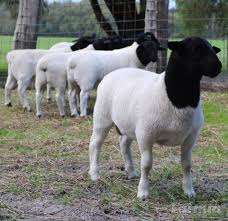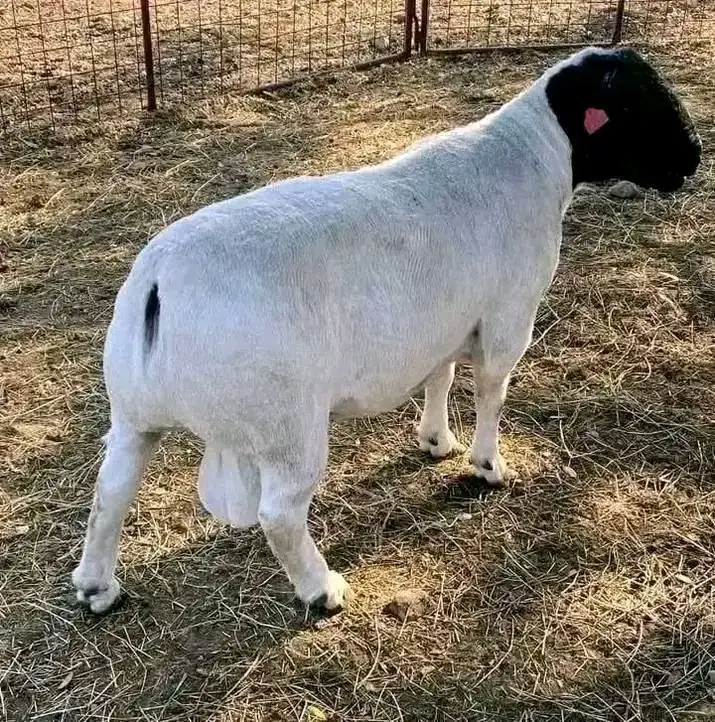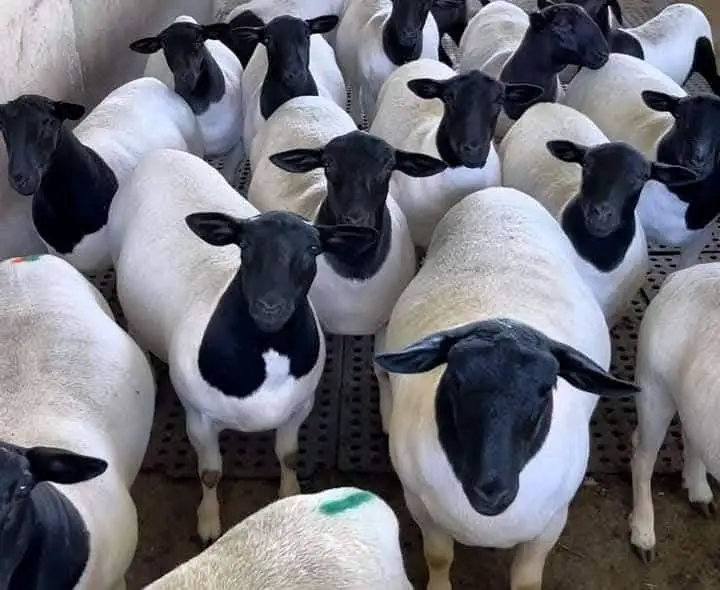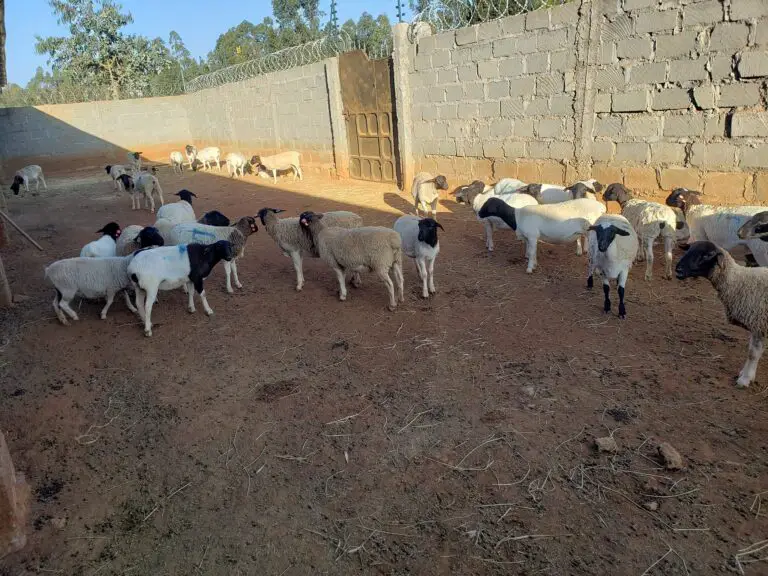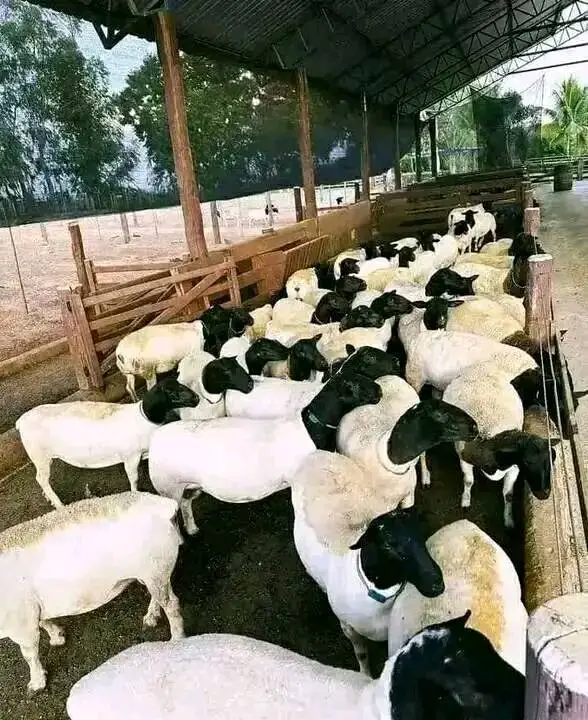Dorper Sheep Feed Requirements
Dorper sheep, renowned for their hardiness and adaptability, are a popular choice for meat production in arid and semi-arid regions, including Kenya.
Their ability to thrive on low-quality forage makes them cost-effective, but optimal nutrition remains critical for growth, reproduction, and profitability.
This article delves into the feed requirements of Dorper sheep, covering dietary components, seasonal adjustments, and practical feeding strategies.
1. Natural Foraging Behavior
Dorpers are natural grazers and browsers, capable of efficiently converting roughage into meat. Their diet in the wild includes:
- Grasses: Rhodes grass, Kikuyu grass, and star grass.
- Browse Plants: Acacia leaves, shrubs, and tree foliage.
- Weeds: Nutrient-rich wild herbs.
Key Trait: Dorpers can maintain weight on sparse vegetation, reducing reliance on expensive supplements.
2. Essential Nutritional Components
Dorper sheep require a balanced diet of carbohydrates, proteins, fats, vitamins, and minerals.
Table 1: Core Nutritional Requirements
| Nutrient | Purpose | Sources |
| Energy (Carbohydrates) | Fuel for growth and maintenance | Pasture, hay, maize, sorghum, wheat bran |
| Protein | Muscle development, milk production | Lucerne, desmodium, sunflower cake, legume hay |
| Minerals | Bone health, metabolic functions | Salt licks (phosphorus, calcium), mineral blocks |
| Vitamins | Immune support, reproduction | Fresh greens, vitamin A/D/E supplements |
| Water | Digestion, temperature regulation | Clean, fresh water (5–8 liters/day per sheep) |
3. Feed Types and Their Roles
A. Pasture and Grazing
- Primary Feed Source: Dorpers thrive on free-range grazing, which constitutes 70–80% of their diet.
- Ideal Pasture Mix: Legumes (e.g., lucerne) combined with grasses boost protein intake.
- Rotational Grazing: Prevents overgrazing and ensures pasture regeneration.
B. Hay and Silage
- Dry Season Solution: During droughts, hay (e.g., Rhodes grass hay) replaces fresh pasture.
- Silage: Fermented maize or sorghum stalks provide energy-rich backup feed.
C. Concentrates and Supplements
Used to fill nutritional gaps, especially for growing lambs and lactating ewes:
- Energy Feeds: Maize germ, wheat bran, or molasses.
- Protein Feeds: Sunflower cake, cottonseed cake, or soybean meal.
- Mineral Mixes: Commercial sheep licks or homemade blends (e.g., bone meal + salt).
Table 2: Daily Feed Ratios for Different Life Stages
| Sheep Category | Pasture/Hay (kg) | Concentrates (kg) | Minerals (g) |
| Adult Ewes/Rams | 2–3 | 0.2–0.5 | 30–50 |
| Lactating Ewes | 3–4 | 0.5–1.0 | 50–70 |
| Lambs (Weaning) | 1–2 | 0.3–0.6 | 20–30 |
| Finishing Lambs | 2–3 | 0.5–0.8 | 30–40 |
4. Seasonal Feeding Adjustments
Dorper feeding strategies must adapt to Kenya’s dry and wet seasons.
A. Wet Season (March–May, October–December)
- Abundant Pasture: Sheep rely on natural grazing with minimal supplements.
- Key Action: Cut and store excess grass as hay for dry months.
B. Dry Season (January–February, June–September)
- Challenges: Poor pasture quality and quantity.
- Solutions:
- Hay: Provide 2–3 kg per sheep daily.
- Silage: Supplement with 1–2 kg per sheep.
- Concentrates: Increase to 0.5–1.0 kg for pregnant/lactating ewes.
5. Specialized Feeding for Key Life Stages
A. Pregnant and Lactating Ewes
- Energy Needs: Increase by 20–30% in late pregnancy and lactation.
- Protein Needs: 12–14% crude protein to support lamb growth and milk production.
- Example Diet:
- 3 kg quality hay + 1 kg lucerne + 0.5 kg maize bran + mineral lick.
B. Growing Lambs
- Pre-Weaning (0–3 months): Depend on ewe’s milk; ensure lactating ewes are well-fed.
- Post-Weaning (3–6 months): Introduce 0.3–0.6 kg concentrates daily (16–18% protein).
C. Breeding Rams
- Pre-Mating: Boost energy with 0.5–1.0 kg concentrates to enhance fertility.
- Off-Season: Maintain on pasture and 0.2–0.3 kg concentrates.
6. Mineral and Vitamin Supplementation
Mineral deficiencies can lead to poor growth, weak bones, and reproductive issues.
Table 3: Critical Minerals and Their Roles
| Mineral | Function | Deficiency Signs | Supplement Sources |
| Calcium | Bone development, milk production | Weak limbs, low milk yield | Bone meal, limestone |
| Phosphorus | Energy metabolism, growth | Poor appetite, stunted growth | Dicalcium phosphate, mineral blocks |
| Copper | Wool quality, immunity | Anemia, faded coat | Copper sulfate, fortified licks |
| Selenium | Reproduction, disease resistance | Infertility, muscle weakness | Selenium-enriched licks |
7. Cost-Effective Feeding Practices
- Plant Drought-Resistant Fodder: Cactus pads, pigeon pea, or Napier grass.
- Recycle Crop Residues: Maize stover, bean husks, or banana stems.
- Formulate Homemade Mixes: Combine wheat bran (50%), sunflower cake (30%), and maize germ (20%).
8. Common Feeding Mistakes to Avoid
- Overfeeding Concentrates: Causes obesity and digestive disorders.
- Poor-Quality Hay: Moldy or dusty hay leads to respiratory issues.
- Ignoring Water Access: Dehydration reduces feed efficiency.
- Inadequate Minerals: Weakens immunity and productivity.
9. Sample Feeding Program for a 50-Sheep Flock
Table 4: Monthly Feed Budget (Dry Season)
| Feed Type | Quantity | Cost (KES) |
| Hay | 3,000 kg | 60,000 |
| Maize Bran | 500 kg | 25,000 |
| Sunflower Cake | 200 kg | 20,000 |
| Mineral Licks | 50 kg | 10,000 |
| Total | 115,000 |
10. Innovations in Dorper Sheep Feeding
- Hydroponic Fodder: Barley or wheat sprouts grown in trays provide high-nutrient feed.
- Silage Pits: Affordable storage for surplus wet-season forage.
- Mobile Apps: Tools like iCow offer real-time feed management advice.
Final Note: Dorper sheep’s feeding regimen must balance cost, nutrition, and local resource availability. Regular body condition scoring and consultation with veterinarians or agricultural extensions can fine-tune diets for maximum productivity.
Data sourced from Kenya Agricultural and Livestock Research Organization (KALRO) and farmer surveys (2023).
